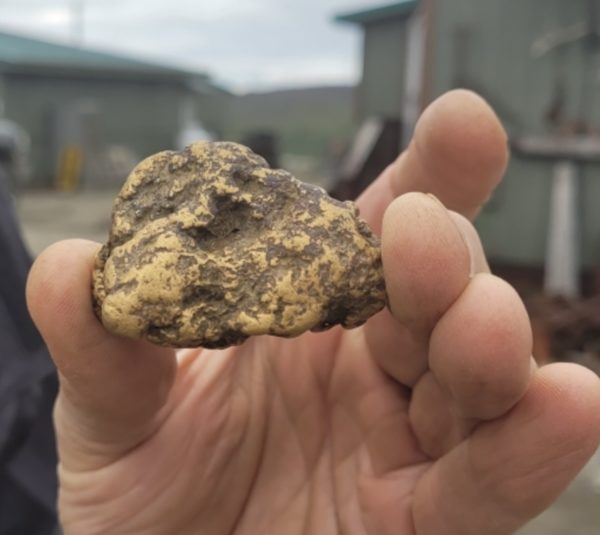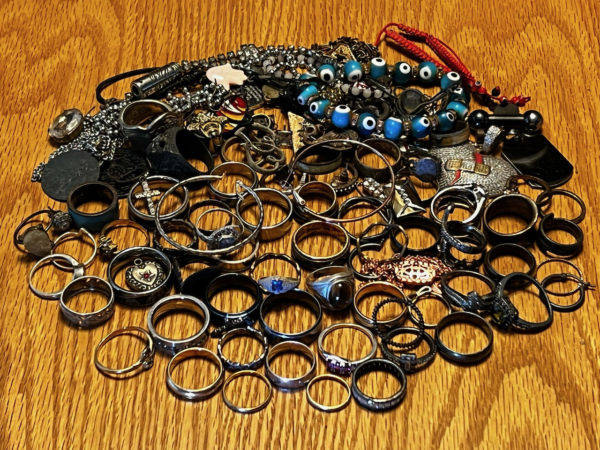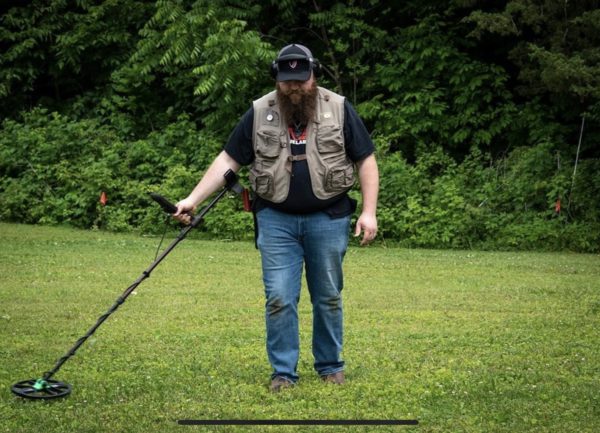Unearthing Treasures from Iowa and Beyond
Category: article
Sep 30th, 2022 by Keith Worrall
Modified Sep 30th, 2022 at 10:36 AM
Minelab Detexpert, Jon White, shares his metal-detecting hobby and passion for history with others

White found this and other gold nuggets in Alaska last year with his Minelab EQUINOX 800 and 6 inch coil.
Jon White had secured permission to detect an old farm site which research showed had been the location of an old schoolhouse. Years earlier, the same ground was an old stagecoach stop. He was sure he would find some great treasures buried on this property.
Step by slow step, he walked across the acreage. His eyes scanned the ground. His ears were tuned to the slightest sound in his earphones. The Minelab EQUINOX 800 he held followed the motion of his arm… right, left, right, left. Anticipation built. He knew it was only a matter of time.
BEEP! The noise startled him even though he had been waiting for it. Anticipation turned to suspense. What caused the beep? A piece of trash? An old coin? A Civil War bullet? A smile crossed his face as he slipped his digger into the ground to expose the hidden item.
Metal detecting is unique. No other hobby offers the same combination of enjoyment, exercise, and excitement, with the added attraction of actually putting valuables in your pocket or fascinating pieces of history into your collection.
White started metal detecting about five years ago. He was always interested in history and started watching television shows like Dig Wars and Diggers, which showcased the hobby of metal detecting. This sparked his interest and led him to join a Facebook site called Detecting the Heartland, created by his friends, Casey and Mindy Oberreuter.
White invested in a popular metal detector and used it for a short period before noticing many of the folks he hunted with were using the Minelab EQUINOX 800. After discussing the properties of this machine and learning more about the Multi-IQ technology it employs, Jon decided to purchase his own EQUINOX 800. Multi-IQ allows the machine to discover it all… silver, gold, jewelry in park, field or beach. All metals. All soils. All the time.
When asked if he was still using the EQUINOX or had switched to a different detector, White says he’s since purchased a Minelab CTX 3030. “I primarily use the 3030 in the water or low-trash areas,” he reports. “But I still prefer the Nox in fields and anywhere else where I need greater trash or iron separation from targets.”
White says he hunts it all, including beaches, yards, fields and woods, and says he enjoys switching between different types of hunting. While most of his detecting is in his home state of Iowa, he has also hunted in Illinois, Wisconsin, Minnesota, Florida, and North Carolina. He recently spent time in Alaska searching for gold nuggets using the EQUINOX 800 with a six inch coil.
Research is high on White’s list when looking for productive field sites. He does a lot of map overlay work ahead of his hunts. He said he also learns about new locations from reading history books that were written in the 1800’s. He occasionally finds old yard sites while doing his research, but usually he finds productive yards by just noticing older house sites during his travels, then obtaining permission for those properties.
White offers advice on gaining permission to hunt private property. “I believe honesty goes a long way. I let someone know a bit about me. I compliment their property. I explain the hobby and then I ask permission to detect there,” he says. “I explain how I would care for their property so they know what to expect. This keeps them engaged in the conversation leading up to asking them.”
White also spends a lot of time teaching others about the hobby. He was asked by a new member of Detecting the Heartland if he could help teach her about using her EQUINOX. The lesson took place at the property described at the beginning of this story. White watched her search and taught her what the different sounds and numbers meant on her machine. They scanned the ground together until they found what he thought was a good target. He let her check it out and learn what a good target sounded like. He was there to guide and teach.
Her first signal was a buffalo nickel. A few minutes later, a V nickel. Next was a target which Jon thought was a canning jar lid. It turned out to be a Civil War breast plate. White was more excited than his companion, knowing what the item actually was. Further research showed there was a military encampment there in the 1840’s, probably to protect the stagecoach travelers from attacks. White was invited back to continue searching the property.
As White dug the signal mentioned at the beginning of our story, just ten feet from where he and his protégé had found the breast plate, he uncovered a rare US Ammunition box plate.
White has several favorite finds. “My best coin find was an 1856 large cent in just my second week of detecting,” he says. “It was at the first permission I landed on my own. The Civil War plates are my best relic finds.” The gold nuggets he found in Alaska are also high on his list.
White says he hunts as much as he can, which is once or twice a week now. Sometimes this is alone, but he prefers “dirt fishing” with friends whenever possible. He attends some seeded hunts, including the Florida Hunt 7 & 8, the Illinois and Iowa Swing Into Summer event, and the Detecting the Heartland hunts, which have a history of selling out all 180 spots in around an hour.
White became a Minelab Detexpert a couple years ago. Part of this title and duty entails helping others learn the hobby. He takes his equipment and goes to local schools and teaches youngsters how to use the equipment and shows them some examples of the history he has uncovered from the ground. Almost always, the teachers are as interested in the presentation as the kids.
Learn more about Minelab Detexpert, Jon White, and follow along on his outings on social media. He can be found on most social media sites by searching Crazy Spider Adventures.

Some of the jewelry found by Jon White in the last year.
Story by Rich Creason
